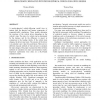Free Online Productivity Tools
i2Speak
i2Symbol
i2OCR
iTex2Img
iWeb2Print
iWeb2Shot
i2Type
iPdf2Split
iPdf2Merge
i2Bopomofo
i2Arabic
i2Style
i2Image
i2PDF
iLatex2Rtf
Sci2ools
WSC
1997
1997
Urban Traffic Simulation with Psycho-Physical Vehicle-Following Models
A psycho-physical vehicle-following model tries to capture both the physical and human components of congested-traffic simulations. These models determine the reactions of the vehicle driver depending on the vehicle’s state. The state of a vehicle can be determined by the distance and by the difference in speed, in comparison to the leading vehicle. If the vehicle state changes, the driver must react. The reaction of the driver is to calculate a new value for acceleration. There are two different classical methods of time advance to calculate the state changes. This paper examines the effect of these methods on simulation run times and simulation results. Empirical experiments were done on a SLX-based simulation model.
| Added | 01 Nov 2010 |
| Updated | 01 Nov 2010 |
| Type | Conference |
| Year | 1997 |
| Where | WSC |
| Authors | Thomas Schulze, Thomas Fliess |
Comments (0)

